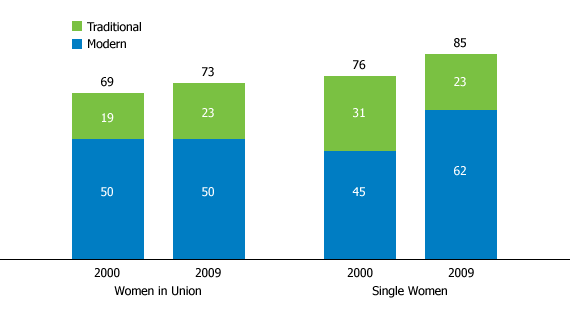
Many Peruvians Rely on Traditional Family Planning Methods
(November 2010) Peruvian women are having fewer children and waiting longer between pregnancies, many by using traditional family planning methods. The 2009 results from an ongoing Demographic and Health Survey (DHS) show that Peru’s average fertility has fallen from 3.5 children per woman in 1996 to 2.6 children per woman. And women were having children about four years apart in 2009, a one-year-longer gap than in 2000.1 These longer birth intervals often translate into healthier mothers and children and a smaller family size.
Contraceptive use among women ages 15 to 49 who were married or in union increased from 64 percent to 73 percent between 2000 and 2009. The increase reflects a greater use of traditional family planning methods rather than modern methods that require medical care or regular supplies. Use of modern methods has not increased since 2000, when one-half of women of reproductive age used a modern method (see figure).
This heavy reliance on traditional methods echoes the family planning preferences of women in neighboring Bolivia, where 26 percent of married women of childbearing age use traditional methods.2 However, use of modern contraceptives is much higher in Peru than in Bolivia (50 percent versus 38 percent), which has helped Peru achieve much lower fertility. According to a 2008 DHS, Bolivian women averaged 3.5 lifetime births—almost one birth per woman higher than the Peruvian rate. At the other end of the spectrum, Peru’s neighbor to the north, Colombia, has a slightly lower fertility rate than Peru (2.4), but much higher use of modern contraceptives: 63 percent of married Colombian women use a modern family planning method, and just 10 percent use a traditional method.3
Percent of Women Using Modern or Traditional Family Planning in Peru, 2000 and 2009

Source: Instituto Nacional de Estadistica e Informatica (INEI) and ORC Macro, Perú: Encuesta Demográfica y de Salud Familiar-ENDES Continua, 2009 (2010), accessed at www.measuredhs.com, on Nov. 3, 2010.
Periodic Abstinence and Hormonal Injections Are Popular
The most popular contraceptive method in Peru is periodic abstinence, which requires women to estimate the days during the month when they are fertile and abstain from sexual relations on those days. While periodic abstinence can prevent pregnancy if strictly followed and if women can correctly estimate their fertile days, it has a higher failure rate than condoms, oral contraceptives, or hormonal injections. Research among American women estimates that about 25 percent relying on the periodic abstinence or “safe days” method will become pregnant under typical conditions.4 The failure rate drops as low as 5 percent with accurate and faithful use. In the Peru DHS, about 17 percent of women who reported that they stopped periodic abstinence for contraception said they did so because they got pregnant. Another 12 percent said they stopped using it to switch to a more effective method.5
The second most used method is hormonal injections. In contrast to periodic abstinence, it has one of the lowest failure rates: Less than 1 percent of women using injections get pregnant.6 Injections have become more popular among Peruvian women since 2000, especially women under age 35, while two other “foolproof” methods, female sterilization and the IUD, have lost ground.
Modern Contraceptive Use Higher Among Single Women
While the vast majority of Peruvian women eventually marry or enter an informal union, they are waiting longer now than earlier generations. This shift, common in other countries, generally signifies that young women are spending more years in school and gaining experience in the job market before marrying. At the same time, women are beginning sexual activity at slightly younger ages. These two trends—earlier sexual activity and marrying later—mean that young women spend more years at risk of an unplanned pregnancy. In recent surveys, there are about three years between the initiation of sexual activity and entering into a marriage or union.7
Single women use family planning at a higher rate than married or in-union women, and they are more likely to rely on modern methods. In 2009, nearly 85 percent of single women who are sexually active used family planning, and 62 percent were using a modern method. The recent results indicate a large increase in modern methods since 2000 among single women. Condoms were the most popular modern method (36 percent), followed by hormonal injections and oral contraceptives (about 10 percent each). Periodic abstinence was the preferred traditional method, used by 14 percent of the single women.
Peru has achieved substantial fertility decline partly through the use of traditional methods such as periodic abstinence. In fact, use of traditional methods has increased since 2000 among married or in-union women, while modern use remained the same. It will be interesting to see whether the preference for modern methods among young single women is maintained after they marry or enter a union, and if Peru’s fertility drops even further.
Mary Mederios Kent is senior demographic writer at the Population Reference Bureau.
References
- Instituto Nacional de Estadistica e Informatica (INEI) and ORC Macro, Perú: Encuesta Demográfica y de Salud Familiar–ENDES Continua, 2009 (2010), accessed at www.measuredhs.com, on Nov. 3, 2010.
- Mary Mederios Kent, “In Bolivia, Slow Fertility Decline and Some Improvements in Health Indicators,” accessed on Nov. 3, 2010.
- Population Reference Bureau, “DataFinder: Colombia,” accessed at www.prb.org, on Nov. 4, 2010.
- James Trussell, “Contraceptive Efficacy,” in Contraceptive Technology, 19th ed., ed. Robert A. Hatcher et al. (New York: Ardent Media, 2007), accessed at www.contraceptivetechnology.org/table.html, on Nov. 4, 2010.
- INEI and ORC Macro, Perú: table 4.13.
- Trussell, “Contraceptive Efficacy.”
- Data from UNFPA, based on analysis of previous DHS surveys for Peru.
